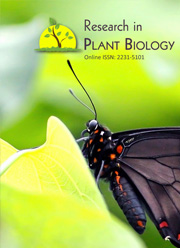Diagnosis of Sclerotinia rot of Indian mustard using spectral approach under field conditions
Keywords:
Indian mustard, spectral indices, Sclerotinia rot, sick plot, disease incidenceAbstract
Field experiments were conducted by growing two varieties (RH 30 and Varuna) ofIndian mustard to diagnose Sclerotinia rot disease using spectral approach during rabi, 2008-09 at CCS Haryana Agricultural University, Hisar, Haryana. The reflected radiance values indifferent IRS Bands were measured with the help of Ground Truth Radiometer (GTR) overcrop surface in all the treatments under natural and sick plot sites from 10.00 a.m. to 12.00noon. The reflectance values in all four bands were also measured over Barium sulphateplate (100% reflection) for using as standard reflectance values over a surface. The per centreflectance values were computed by taking the ratio of radiance value over a crop surfaceand standard radiance value over a Barium sulphate plate. These spectral reflectance valuesin IRS bands were used for computing spectral indices: vegetation index, normalizeddifference vegetation index, perpendicular vegetation index and disease water stress indiceson the same dates of observations on disease incidence. The maximum disease incidence wasrecorded in first date of sowing and it decreased drastically with delay in sowings. Themaximum incidence in first date of sowing was 27.6 and 25.6 per cent in RH-30 and Varuna,respectively. The reflectance values were higher in visible bands over natural site (healthycrop) in comparison to sick plot site (diseased crop). A reverse trend was observed in case ofinfra red reflectance over natural and sick plot site surface. The vegetation index values werehigher at natural site as compared to sick plot site except disease water stress index-4. Theregression model based on significant vegetation indices explained the variability in diseaseincidence upto 81 and 86 per cent in RH 30 and Varuna, respectively. Based upon the presentfindings, the spectral approach can be used as a diagnostic tool for stem rot incidence inmustard crop under field conditions.Downloads
Download data is not yet available.
Published
22-08-2013
How to Cite
Kumar, A., Narwal, S., Rathi, A., Avtar, R., & Niwas, R. (2013). Diagnosis of Sclerotinia rot of Indian mustard using spectral approach under field conditions. Research in Plant Biology, 3(4). Retrieved from https://updatepublishing.com/journal/index.php/ripb/article/view/2504
Issue
Section
Articles






 .
.